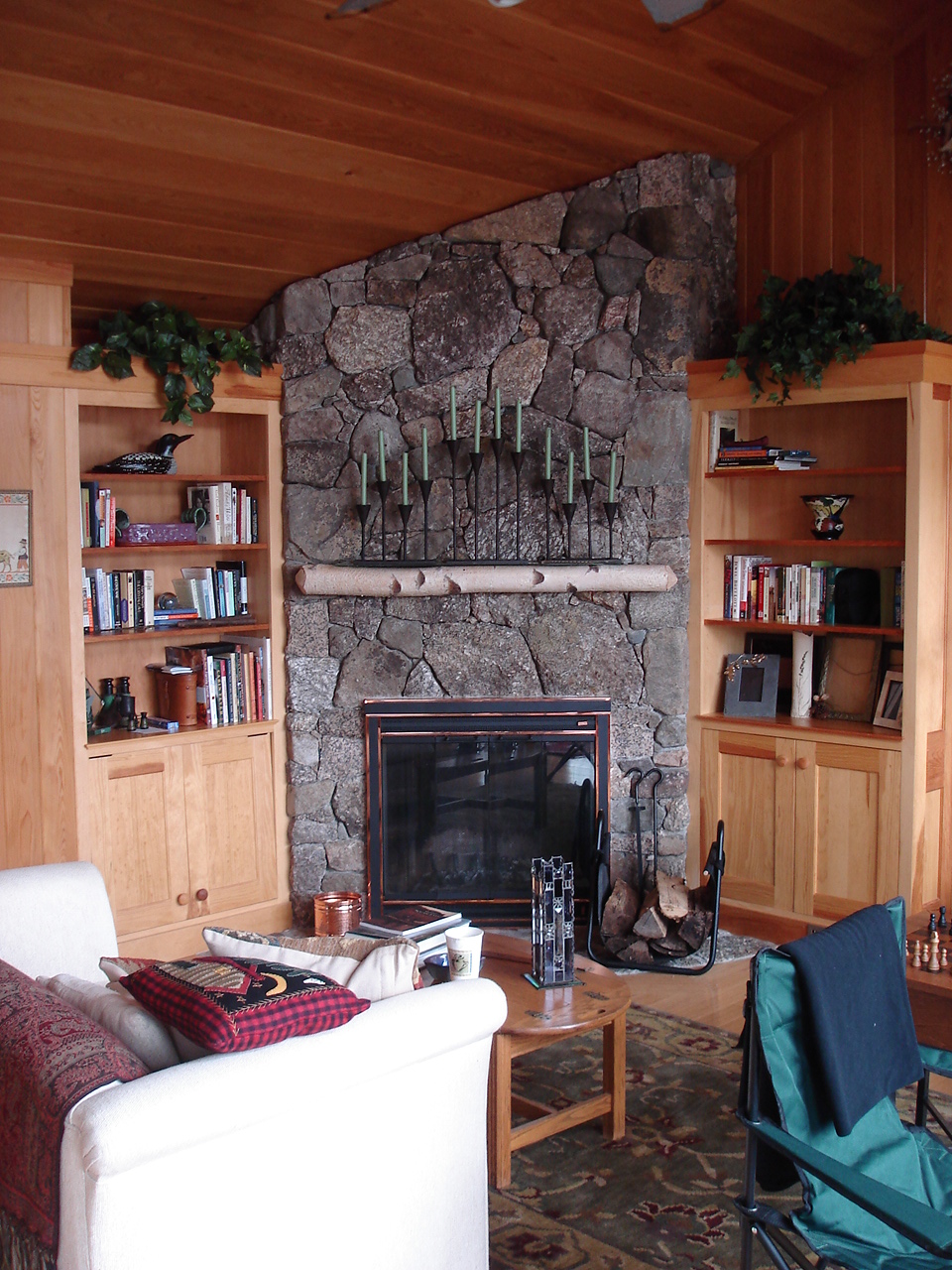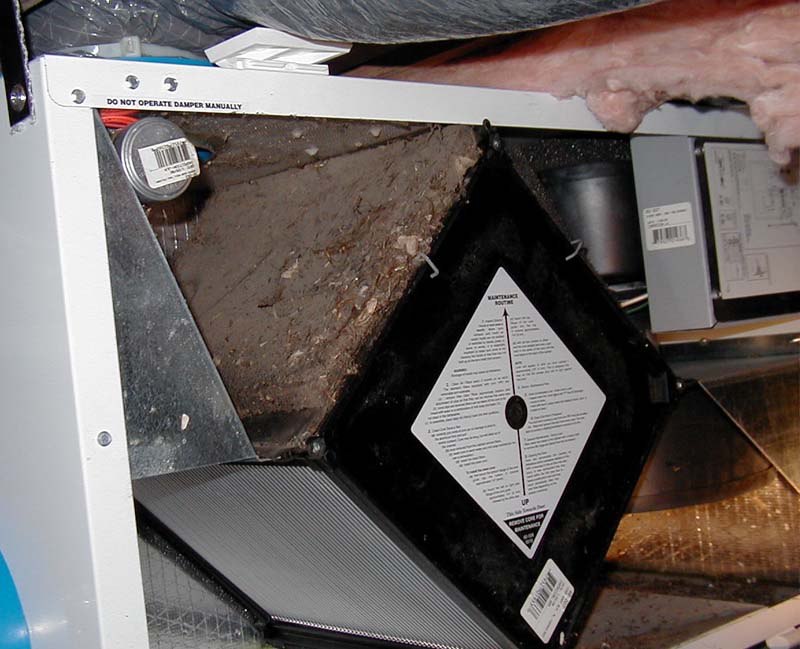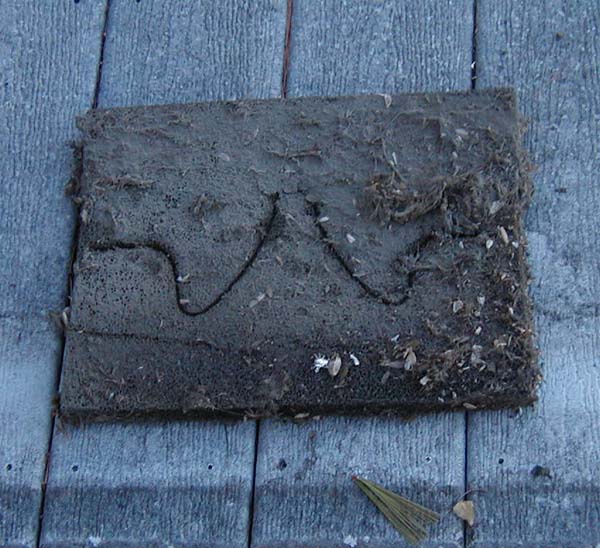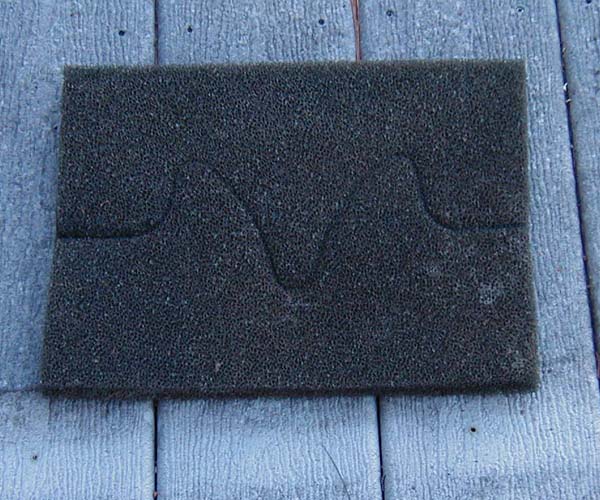Plugged Intake Air Filter
"Smoke Gets in Your Eyes"
|
Please let me know how we can best satisfy this so that you can become confident with the system.
Best regards, ***** Jack, Thanks for forwarding this to me. Dennis' explanation makes perfect sense - and it will be easy to see if that's the problem by verifying that you have an up-draft in your cold chimney when the filter is cleaned and replaced. Pleas let me know if this was , in fact the problem. And send me one more picture with a nice fire in your fireplace.
Best, Thanks for the pictures, Jack. Let me know what you find out after trying the suggestions I made yesterday. I look forward to working with you. Best, Jim
On Thu, Mar 11, 2010 at 5:07 PM, Jack McDaniel
Jim
I dug out some old photos of the original red brick fireplace (see how beautiful that flame is?!!) and photos showing work-in-process as the new Rumford was being constructed. What I wanted was the performance of the old red bricker with the location and look of the Rumford!
Comments welcome!
Thanks again!
Jack McDaniel
Holderness, NH
508 835 9000 x130
*********
Jack,
Sorry to hear that "smoke gets in your eyes". I think you at least suspect what the problem is - probably inadequate make-up air in a tight well-built house. But let's try to confirm that and quantify it before thinking of solutions.
We have a "Smoky Fireplace Checklist" on line at http://www.rumford.com/smoky.html It assumes that you have a Rumford fireplace and you say you have a “Rumford-style” fireplace but the tests should still apply.
The first thing we do is get a stick of incense and make sure there is an updraft in the chimney when it's cold. If not, do whatever it takes to get draft by opening up doors and windows and turning off bath and kitchen fans. You say the chimney is several feet above the highest point in the roofline so that shouldn't be a problem. Then see if the fireplace works. Don't be concerned about being cold. This is a test - not a solution. Open the doors and windows wide to eliminate any problem with negative indoor air pressure so you can see if the fireplace has any design problem. It could have an obstruction, half closed damper, bird nest, too small of a flue, restrictive rain cap. Consider and remove all these possible problems and open things up. Run a brush or rag through the flue just in case there are cobwebs you can't see that restrict.
If the fireplace won't draw or work properly in this situation then send me dimensions of the fireplace, throat area, flue - and pictures of the chimney and fireplace, including up the throat so I can see the throat and damper area.
If the fireplace does work with the doors wide open then the problem is almost certainly an air pressure problem. This is what I suspect since it is usually the problem and because your mason has built many fireplaces that do work.
The rest of the paper at http://www.rumford.com/smoky.html deals with ways to figure out how to insure an updraft in a cold chimney under normal living conditions. Run through the suggestions with your stick of incense and let me know what you find out. Take your time, Isolate one variable at a time. And let me know. The reason you must control the ventilation system so as to insure an up draft in the chimney when it's cold is because, even if you can overcome the downdraft, at some point as the fire dies down and loses power, it won't have enough power to overcome the downdraft and your fireplace will smoke or at least your house will smell like smoke and ash after the fire has gone out. Find a better way to ventilate your cabin than down the chimney.
Follow the links and read further about balancing the ventilation system at http://www.rumford.com/ventilation.html
You should be able to look forward to trashing those fireplace doors and I'm glad you sent the Exhausto fan back. Hopefully you will not have to do anything expensive. Resist throwing solutions at the problem until you know what the problem is.
Let me know what you find out.
Best,
Jim Buckley
On Thu, Mar 11, 2010 at 12:52 PM, Jack McDaniel
Hi Jim -
Hope this finds you well. I have read a lot about you on the internet – and when it comes to Rumford and Rumford style fireplaces, it appears that you are the “go to guy”.
While the song “Smoke Gets in Your Eyes” may have been a successful hit for The Platters back in the late 50’s, it unfortunately also serves to explain what occurs when I try to make a fire in my “Rumford-style” fireplace. I bought a 900 sq.ft. cabin on Squam Lake in Holderness NH (“site of the movie “On Golden Pond”) and had it fully remodeled from the studs out by a top-quality builder here in New Hampshire. He has built many large, multi-M homes both on Squam and on Lake Winnipesauke, the two largest fresh water lakes in New Hampshire. Attached is photo of the current fireplace. Before the remodel, the old red brick fireplace which was positioned on an outside wall, worked perfectly. No glass doors were needed and smoke never backed up into the cabin. I enjoyed many fires and at any point in the cycle of the fire, smoke back up was never a problem and in the morning, there was nothing other than fine ashes in the bottom of the fireplace. The cabin was originally built in 1964 and needless to say it had lots of “fireplace-friendly” drafts.
The remodel included the addition of all new Pella windows and doors, insulation and a new roof - the cabin is now super super-tight – which as I have come to learn from your writing and that of others, is not helpful when it comes to fireplaces.
As part of our the remodel plan, the builder suggested and I agreed to relocate the fireplace and make a new stone “floor to ceiling” fireplace the focal point of the living room and in fact of the entire cabin. My goal was to be able to have a roaring fire while I sat listening to loons on the lake, absorbed in mindless paperback novels, supping a cup of green tea. Sound good? It sure did to me! The fireplace has been a disaster from the start and remains a bone of contention between the builder and me. The fireplace simply does not draft well. No suckage! It is so bad that I could not in conscience sell the cabin as it is with the way the fireplace fails to function. Here are some of the things that the builder, his crew, his subcontractors and I together have tried, none of which have produced satisfactory results:
a. We confirmed that the top of the chimney is several feet above the highest point in the roofline. When we discovered how poorly the fireplace worked, the stone mason came back and went up on the roof, and placed several additional sections of flue liner (to effectively increase the height of the chimney) to see if that would help - and after we all agreed that it did not so he took them down and retuned them to his masonry supplier. The craftsman Nat Green has been building fireplaces for 25 years and he admitted that not only was he thoroughly puzzled, but he said this was the worst performing fireplace he had even seen. We’ve tried burning fires with the windows and even doors opened up a crack and in some cases, all the way open; with only modest improvement (and of course we freeze!). I read about and later convinced the builder to purchase and temporarily install an Exhausto chimney fan – which he powered up and positioned on the very top of the chimney. No help. He returned it. We remained perplexed.
b. On further research, I read about and the builder agreed to install an AIR HANDLER to “make up’ air in the cabin. He installed it and there is presently a single 4” x 10” vent in the living room, located in a baseboard of a cabinet located about 3 feet from the (right side of the) fireplace. You can see just a corner of it in the photo. It blows a moderate amount of air into the cabin - you can definitely feel it when you put your hand front of the vent. I turn it on and off via a circuit breaker in the panel. When we arrive at the cabin, I immediately turn it on and leave it on the entire time we are there. It has improved things a little – but the fireplace still functions very poorly. I visit other people and am amazed at how effortlessly their fireplaces seem to function. My black heart remains selfishly jealous.
c. Glass doors with vents on top and bottom were a must! This is one of the very first things we were forced to install. Without them, there is no way you could live in the cabin and try to enjoy a fire. The glass doors go against everything we wanted when we remodeled the cabin - which was a nice open stone feeling.
When I first light the fire, I make sure that the AIR HANDLER is on and then make sure the damper in the fireplace is opened up all the way (I guess with the glass doors you really don’t even need a damper, do I?) Then I check to make sure the louvered vents at the bottom of the glass doors are opened all the way up. There is a row of louvered vents along the top edge of the glass doors but I was told those aren’t so important - I tend to leave them closed so the air will come into the bottom of the glass door units and not come back into the cabin via the top row of louvered vents.
When first lighting the fire, the smoke quickly begins to back up into the cabin and I have to quickly shut the glass doors. The smoke detectors occasionally sound off. When the fire gets really going, you can open up the glass doors and as long as there is a roaring fire, very little smoke backs up into the cabin; but you always know it’s coming very soon – so it is always on your mind… which it immediately does when the logs begin to burn down - at which time, smoke backs up into the cabin again. You have to quickly close the doors! The fire required constant attention! The doors to the bedrooms must remain closed at all times or the rooms will become so smoke filled that you can’t sleep comfortably at night. Even doing the best that we can, when guests enter the cabin, they always say the same thing: "What’s the matter! This place smells so smoky!!!!". If we stay for even one day, our clothes smell like smoke and we have to wash them or take them to the dry cleaners when we get home. At the end of a fire cycle, the logs never completely burn out. In the morning, there are always several logs which are half burned and I end up throwing them into the woods.
Jim I am at my wits' end. I have no answer. The builder is a nice guy and he and his stonemason have tried their best. I need you and your experience! As a logical person, I feel like there must be a solution - and without regard to the cost of doing so, this must be fixed.
Couple of closing comments:
Do you think we need a make up system with more oomph? (Larger Motor? More CFM? More Vents? Vents located in a different part or parts of the cabin?)
Could a hole or holes be drilled right into the chimney which would allow the air from the outside to enter into the inside of the chimney stack?
Can someone please explain to me why the smoke isn’t getting pulled up (sucked up) efficiently into the chimney?!
Will the day ever come where we can take those glass doors and throw them in the dumpster? (We'll have a party!)
By the way, Jim, this happens without regard to what the outside temperature is; either from 5 degrees F up to 50F - similar results.
I wish you were closer geographically. I'd send a car to pick you up.
Right now, the builder, who has an excellent reputation locally (without regard to this tiff which remains an "open switch" between us) wants to make me a satisfied customer - but so far, the answer has eluded everyone who has looked at it.
Looking for a remedy and fully willing to engage and compensate you for any help you can provide, I am
Sincerely,
Jack McDaniel
39 Grapevine Cove Road; Holderness, NH
508 835 9000 x130
EMAIL: jack@mcdaniel.org
|

Buckley Rumford Fireplaces
Copyright 1996 - 2010 Jim Buckley
All rights reserved.
webmaster



